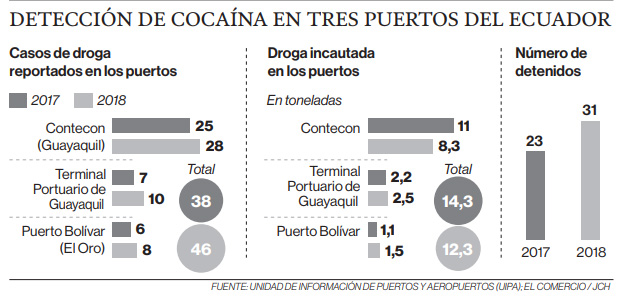Mafias study the routes and destinations of exports
Ecuadornews:

The anti-drug control in the Maritime Port of Guayaquil is permanent. Agents and trained dogs check the loaded containers, which are located in the yards before they are shipped on ships. Intelligence teams warn that in this area of the terminal, operated by Contecon, every week at least one drug case is discovered.
The main destination is Europe, where the kilo of the cargo costs USD 50 000. The presence of drug trafficking networks has also been detected in the Port Terminal of Guayaquil (TPG), operated by a Chilean group, and in Puerto Bolívar, in El Oro, Delegate to the company Yilport. According to the investigations, the mafias capture people responsible for violating the security of the Police and Customs and introduce the packages.
The national head of the Ports and Airports Information Unit (UIPA), Cristhian Proaño, says that this way of operating is repeated in other ports and that the criminal networks also intercept the containers before they reach the ports and hide the blocks of drugs. The most vulnerable products to be contaminated with cocaine are bananas, mango, pineapple, shrimp and fish, because they are the ones that come out most from the ports of Ecuador.
The intelligence services have also detected groups that use clandestine mechanical workshops to create secret compartments inside the containers. But the narcotics are also hidden in the cooling systems of the ‘reefer’ containers, which are installed between the floor and the ceiling.
Proaño says that to carry out the entire operation, the suspects filter information related to the dates of shipment, type of fruit or canned, sea route, travel time and port of destination. On October 30 of last year, researchers detected a clandestine warehouse in the canton Durán (Guayas).
In that place a container was found that had hidden drug between sacks, with dry leaves of corn that went to Europe. When narcotics enter the containers, drug traffickers know exactly which container to intercept. Infiltrations occur at night or at dawn. Behind these illicit operations are Colombian and Mexican mafias, according to police intelligence.

However, the scanners with which the police and dogs count allow to detect the hidden drug within the exportable merchandise. On December 24, 756 kg of cocaine were found among boxes of bananas that went to Holland.
The cargo controls are carried out randomly, based on a risk profile. The selection of which container will be examined depends on the product, the weight, the country of origin and the regularity with which the company exports abroad. The agents admit that only 10% of the export cargo is checked in the Guayaquil ports. In 2018, more than 700,000 containers were sent through the public and private terminals of the Main Port. The days of greatest influx or report of cases are from Thursday to Sunday.
In 2018, 46 cases were registered in three ports, eight more than in 2017. Although 12.3 tons of drugs were seized, 2 tons less than in 2018.

The ports of Guayaquil represent the greatest seizure, since 80% of the products are exported there. That’s why the Police has 23 trained dogs in the city, a fixed and a mobile scanner. But those controls are not enough.
Some organizations expect ships to leave the port and wait in the quarantine area, a maritime zone in the Gulf of Guayaquil, where they wait before leaving to the high seas. There, the mafias send people who go by speedboats and board the boats to place drugs in the containers or in some part of the ship.
A case like this was detected by the Police in April 2018. Two people who were in a boat with jute sacks were arrested. Those involved carried drugs and ropes to raise the illicit cargo to a ship.
The most powerful groups use divers and underwater welding equipment to place metal capsules with drugs in the ship’s hull. Infiltrations do not only occur in ports. Javier Moreira, general manager of the shipping company CMA-CGM, admits that the narcos study the security measures of the companies.
For example, when the shipping company used bottle-shaped locks to seal the containers, the criminal networks falsified them even with the numbering. That way they opened the container, introduced drugs and sealed it again. Now, these padlocks come in airtight cases so you cannot see the color or the code. The exporter is in charge of sealing the merchandise. (I)
Source: https://www.elcomercio.com/actualidad/mafias-rutas-destinos-exportaciones-puertos.html





